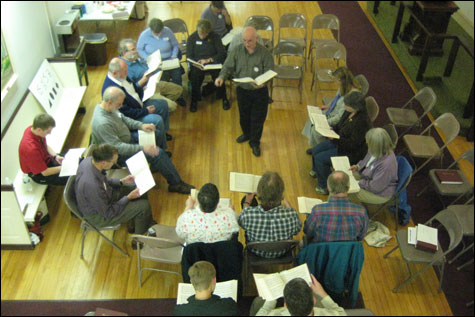
SACRED SPACE: Singers form a "hollow square." |
I arrive at my first shape note singing session — held in Waterville's oldest public building, the white and gleaming First Baptist Church — at 2 pm. Once the last stragglers arrive, about thirty of us are seated in metal folding chairs in the building's lobby. The bulk of the crowd is middle-aged or older, but there are two clean-cut teenage boys and a few twenty- or thirtysomethings. Our chairs are arranged in a square: alto singers face tenors; trebles face bass singers. A few regulars scramble to find enough songbooks to pass out to those of us newcomers gathered here.
About two-thirds of us have never attended this shape note group — one of four formal groups in Maine — before; probably a handful have never been to one at all. I've heard and read plenty about shape note singing — how simple it is to learn, how unorthodox its tones and harmonies are, how communal and infectious these gatherings are — but I'm curious about why this devout, centuries-old tradition is gaining traction among young people in the Northeast.

Shape note singing requires that you forget most of what you know about reading music. It's different, but much simpler. Shape note departs from the structure of traditional solfège scales (do, re, mi, fa, sol, la, ti); the seven notes remain, but you're only singing four corresponding syllables: fa, sol, la, and (sometimes) mi. (As the scale ascends, these syllables repeat in perfect fourths, so singing them at different pitches remains both harmonically appropriate and tuneful.) On the sheet music, each note is represented by a shape: triangle, circle, square, and diamond, respectively. At shape note singings — which are usually called Sacred Harp singings, after the main text of the shape note style — the first run-through of each song is done by singing those four syllables at the corresponding pitches on the page. Immediately after the run-through, participants replace their fas and las with the song's lyrics.
The regulars in Waterville seem surprised by the robust attendance, but I suspect many of the newcomers came for the same reasons I did. Sacred Harp singing — a style as devout and old-timey as it is jarring and unusual — is in the midst of a grassroots renaissance, particularly in the Northeast, where the tradition died off sometime after the Civil War as churches deferred to more scientific and classically beautiful choral music. (It persisted in the deep South, where the groups are largest today.)
Curiosity about the Sacred Harp persists through a series of cultural flashpoints: a few scenes of singings in the film Cold Mountain; YouTube videos of large gatherings; a new documentary film, Awake, My Soul: The Story of the Sacred Harp, directed by young Sacred Harp historians Matt and Erica Hinton. Shape note singings are held in churches and other venues in at least thirty states (most of them east of the Mississippi, where the tradition originated), and groups of twentysomething hipsters and hippies gather at universities, bars, and homes throughout the Northeast, from New York City club the Living Room to a home in South Portland.
Golden oldies
Peter Golden, the pleasant and unceasingly reassuring organizer of Waterville's monthly singing, explains Sacred Harp to the new singers. (There's no "audience" or "crowd" here; everyone participates.) Sacred Harp music unofficially began in rural England in the 1700s; the first hymnal of what was called "country parish music" used in America was published in 1764. American composers of the new form, mostly based in New England, also led singing schools for parishioners and children. In the process, they composed many of the hundreds of songs comprising the predominant shape note text, called the Sacred Harp. (Apart from the Bible, it was the most popular book in America until the Civil War.) Shape notes, the Sacred Harp's stock in trade, were created to make the process of learning to sing easier.
Sight reading a Sacred Harp song isn't easy for an untrained singer, but after one or two relatively simple songs you get the gist of it. (The elaborate melodies and harmonies of fugueing songs are more challenging, but also a lot more fun.) Moreover, there's no expectation among your peers that you'll get it right the first time. Sacred Harp singings are, by design, still referred to as "lessons." And, as Golden noted, "If you don't want to learn the shapes, just sing la. You'll be right a quarter of the time."
Before the first song begins, Chris Holley, a bass singer seated in front of me, interjects. "There's just one more thing, before people get surprised. We sing loud."
Indeed. Golden leads the first song, standing in the middle of our seated group, facing the tenor contingent, the dominant group of any Sacred Harp singing. He called out "49 bottom," the song "Mear," written by Isaac Watts in 1719. (Sacred Harp songs are commonly referred to by their page number; many pages contain two compact songs.) A couple tenors begin quietly singing the first note — fa for all four sections, in this case —to establish a relative pitch all of the singers could agree on.